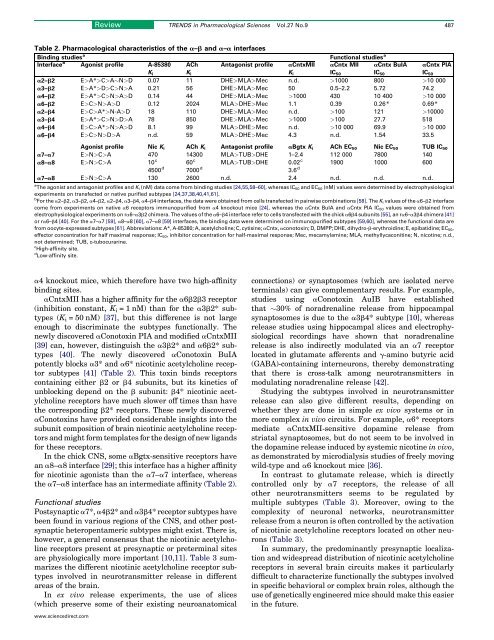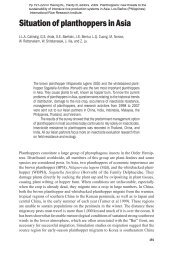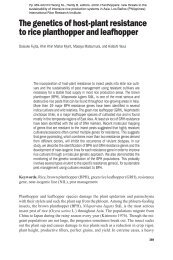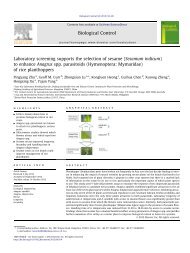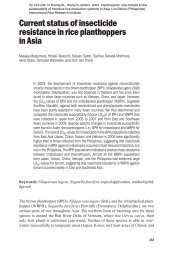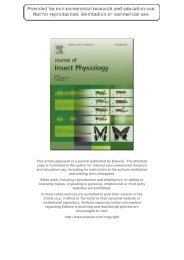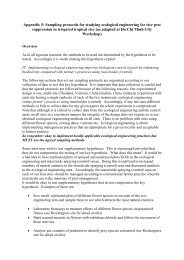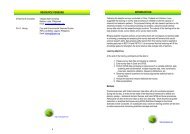Brain nicotinic acetylcholine receptors: native ... - Ricehoppers
Brain nicotinic acetylcholine receptors: native ... - Ricehoppers
Brain nicotinic acetylcholine receptors: native ... - Ricehoppers
You also want an ePaper? Increase the reach of your titles
YUMPU automatically turns print PDFs into web optimized ePapers that Google loves.
Review TRENDS in Pharmacological Sciences Vol.27 No.9 487<br />
Antagonist profile aCntxMII<br />
Table 2. Pharmacological characteristics of the a–b and a–a interfaces<br />
Binding studies a<br />
Functional studies a<br />
Interface b Agonist profile A-85380 ACh<br />
aCntx MII aCntx BuIA aCntx PIA<br />
K i<br />
K i K i<br />
IC 50<br />
IC 50<br />
IC 50<br />
a2–b2 E>A*>C>AN>D 0.07 11 DHE>MLA>Mec n.d. >1000 800 >10 000<br />
a3–b2 E>A*>D>C>N>A 0.21 56 DHE>MLA>Mec 50 0.5–2.2 5.72 74.2<br />
a4–b2 E>A*>C>N>A>D 0.14 44 DHE>MLA>Mec >1000 430 10 400 >10 000<br />
a6–b2 E>C>N>A>D 0.12 2024 MLA>DHE>Mec 1.1 0.39 0.26* 0.69*<br />
a2–b4 E>C>A*>N-A>D 18 110 DHE>MLA>Mec n.d. >100 121 >10000<br />
a3–b4 E>A*>C>N>D>A 78 850 DHE>MLA>Mec >1000 >100 27.7 518<br />
a4–b4 E>C>A*>N>A>D 8.1 99 MLA>DHE>Mec n.d. >10 000 69.9 >10 000<br />
a6–b4 E>C>N>D>A n.d. 59 MLA>DHE>Mec 4.3 n.d. 1.54 33.5<br />
Agonist profile Nic K i ACh K i Antagonist profile aBgtx K i ACh EC 50 Nic EC 50 TUB IC 50<br />
a7–a7 E>N>C>A 470 14300 MLA>TUB>DHE 1–2.4 112 000 7800 140<br />
a8–a8 E>N>C>A 10 c 60 c MLA>TUB>DHE 0.02 c 1900 1000 600<br />
4500 d 7000 d 3.6 d<br />
a7–a8 E>N>C>A 130 2600 n.d. 2.4 n.d. n.d. n.d.<br />
a The agonist and antagonist profiles and K i (nM) data come from binding studies [24,55,58–60], whereas IC 50 and EC 50 (nM) values were determined by electrophysiological<br />
experiments on transfected or <strong>native</strong> purified subtypes [24,37,38,40,41,61].<br />
b For the a2–b2, a3–b2, a4–b2, a2–b4, a3–b4, a4–b4 interfaces, the data were obtained from cells transfected in pairwise combinations [58]. The K i values of the a6–b2 interface<br />
come from experiments on <strong>native</strong> a6 <strong>receptors</strong> immunopurified from a4 knockout mice [24], whereas the aCntx BuIA and aCntx PIA IC 50 values were obtained from<br />
electrophysiological experiments on ra6–a3b2 chimera. The values of the a6–b4 interface refer to cells transfected with the chick a6b4 subunits [55],anra6–a3b4 chimera [41]<br />
or ra6–b4 [40]. For the a7–a7 [59], a8–a8 [60], a7–a8 [59] interfaces, the binding data were determined on immunopurified subtypes [59,60], whereas the functional data are<br />
from oocyte-expressed subtypes [61]. Abbreviations: A*, A-85380; A, <strong>acetylcholine</strong>; C, cytisine; aCntx, aconotoxin; D, DMPP; DHE, dihydro-b-erythroidine; E, epibatidine; EC 50 ,<br />
effector concentration for half maximal response; IC 50 , inhibitor concentration for half-maximal response; Mec, mecamylamine; MLA, methyllycaconitine; N, nicotine; n.d.,<br />
not determined; TUB, D-tubocurarine.<br />
c High-affinity site.<br />
d Low-affinity site.<br />
a4 knockout mice, which therefore have two high-affinity<br />
binding sites.<br />
aCntxMII has a higher affinity for the a6b2b3 receptor<br />
(inhibition constant, K i = 1 nM) than for the a3b2* subtypes<br />
(K i = 50 nM) [37], but this difference is not large<br />
enough to discriminate the subtypes functionally. The<br />
newly discovered aConotoxin PIA and modified aCntxMII<br />
[39] can, however, distinguish the a3b2* and a6b2* subtypes<br />
[40]. The newly discovered aConotoxin BuIA<br />
potently blocks a3* and a6* <strong>nicotinic</strong> <strong>acetylcholine</strong> receptor<br />
subtypes [41] (Table 2). This toxin binds <strong>receptors</strong><br />
containing either b2 orb4 subunits, but its kinetics of<br />
unblocking depend on the b subunit: b4* <strong>nicotinic</strong> <strong>acetylcholine</strong><br />
<strong>receptors</strong> have much slower off times than have<br />
the corresponding b2* <strong>receptors</strong>. These newly discovered<br />
aConotoxins have provided considerable insights into the<br />
subunit composition of brain <strong>nicotinic</strong> <strong>acetylcholine</strong> <strong>receptors</strong><br />
and might form templates for the design of new ligands<br />
for these <strong>receptors</strong>.<br />
In the chick CNS, some aBgtx-sensitive <strong>receptors</strong> have<br />
an a8–a8 interface [29]; this interface has a higher affinity<br />
for <strong>nicotinic</strong> agonists than the a7–a7 interface, whereas<br />
the a7–a8 interface has an intermediate affinity (Table 2).<br />
Functional studies<br />
Postsynaptic a7*, a4b2* and a3b4* receptor subtypes have<br />
been found in various regions of the CNS, and other postsynaptic<br />
heteropentameric subtypes might exist. There is,<br />
however, a general consensus that the <strong>nicotinic</strong> <strong>acetylcholine</strong><br />
<strong>receptors</strong> present at presynaptic or preterminal sites<br />
are physiologically more important [10,11]. Table 3 summarizes<br />
the different <strong>nicotinic</strong> <strong>acetylcholine</strong> receptor subtypes<br />
involved in neurotransmitter release in different<br />
areas of the brain.<br />
In ex vivo release experiments, the use of slices<br />
(which preserve some of their existing neuroanatomical<br />
connections) or synaptosomes (which are isolated nerve<br />
terminals) can give complementary results. For example,<br />
studies using aConotoxin AuIB have established<br />
that 30% of noradrenaline release from hippocampal<br />
synaptosomes is due to the a3b4* subtype [10], whereas<br />
release studies using hippocampal slices and electrophysiological<br />
recordings have shown that noradrenaline<br />
release is also indirectly modulated via an a7 receptor<br />
located in glutamate afferents and g-amino butyric acid<br />
(GABA)-containing interneurons, thereby demonstrating<br />
that there is cross-talk among neurotransmitters in<br />
modulating noradrenaline release [42].<br />
Studying the subtypes involved in neurotransmitter<br />
release can also give different results, depending on<br />
whether they are done in simple ex vivo systems or in<br />
more complex in vivo circuits. For example, a6* <strong>receptors</strong><br />
mediate aCntxMII-sensitive dopamine release from<br />
striatal synaptosomes, but do not seem to be involved in<br />
the dopamine release induced by systemic nicotine in vivo,<br />
as demonstrated by microdialysis studies of freely moving<br />
wild-type and a6 knockout mice [36].<br />
In contrast to glutamate release, which is directly<br />
controlled only by a7 <strong>receptors</strong>, the release of all<br />
other neurotransmitters seems to be regulated by<br />
multiple subtypes (Table 3). Moreover, owing to the<br />
complexity of neuronal networks, neurotransmitter<br />
release from a neuron is often controlled by the activation<br />
of <strong>nicotinic</strong> <strong>acetylcholine</strong> <strong>receptors</strong> located on other neurons<br />
(Table 3).<br />
In summary, the predominantly presynaptic localization<br />
and widespread distribution of <strong>nicotinic</strong> <strong>acetylcholine</strong><br />
<strong>receptors</strong> in several brain circuits makes it particularly<br />
difficult to characterize functionally the subtypes involved<br />
in specific behavioral or complex brain roles, although the<br />
use of genetically engineered mice should make this easier<br />
in the future.<br />
www.sciencedirect.com


